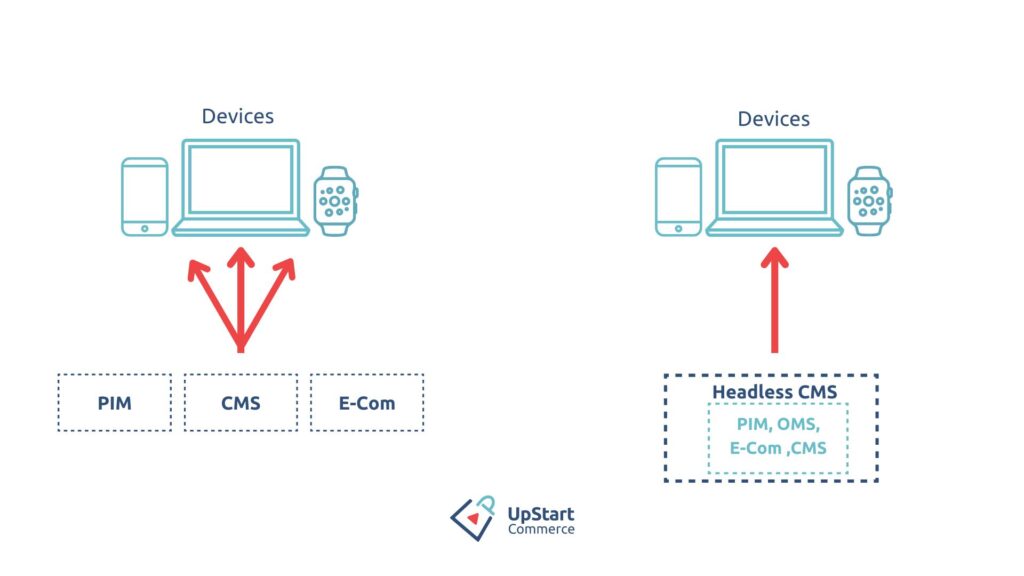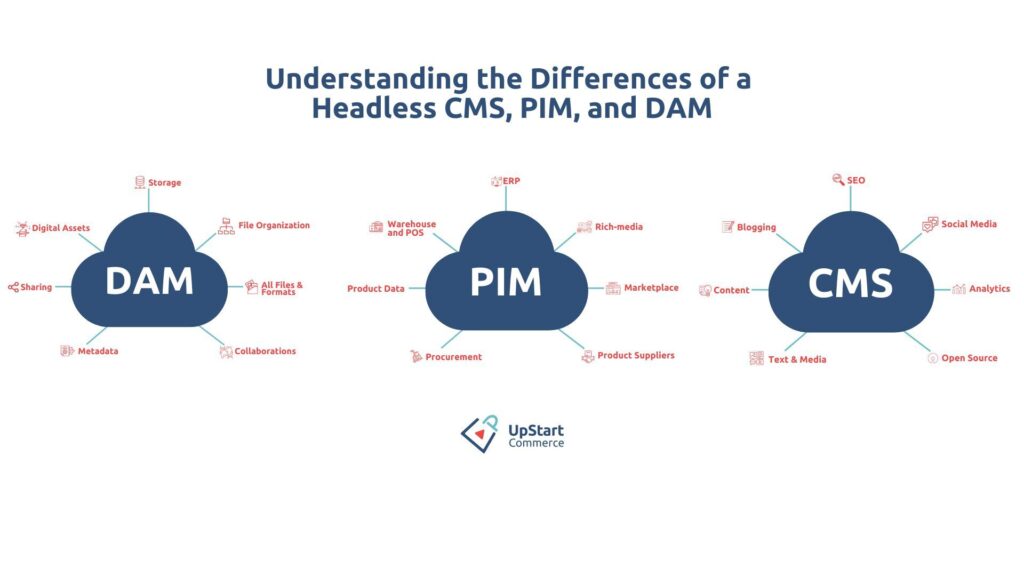Ecommerce businesses of every size need to prepare their websites for Black Friday. Any business can experience website or application crashes with an increased influx of traffic, regardless of previous experiences. A study conducted by Fresh Relevance, a CRM company, found that Black Friday ecommerce traffic increases 162% compared to other days. There are many advantages of using a headless CMS to improve localization, mobile experiences, and PIM connectivity during Black Friday. Further in this blog, we will compare the functions of a headless CMS vs PIM platform.
Using a headless approach for ecommerce platforms helps avoid website crashes and lost revenue. In fact, a combination of the headless CMS, PIM, and DAM will help websites run smoothly during Black Friday.
Read the blog 15 KPIs to Measure Retail Website’s Success This Holiday Season to start measuring your ecommerce performance this retail holiday season.
Headless Content Management System (CMS)
A report by Diginomica, a media/analyst property, suggests that 11% of businesses that implemented a headless CMS saw an overall increase in satisfaction in user experiences.
What does Headless CMS Do?
A headless content management system (CMS) stores content in one location and distributes it to all connected frontends. The body of the content management system, or the repository, is separated from the front-end presentation layer. API calls make it easy to integrate content on any website, application, or platform. Using a headless CMS creates a truly unified commerce experience for customers.
What is unified commerce? Read our blog “What is Unified Commerce? And Why is it a Necessity in 2022?” to find out more.

Advantages of Headless CMS
Here are some of the advantages of using the headless CMS approach:
Faster Content Delivery
A headless CMS keeps content in one place so that content is available across multiple channels. This saves time when it comes to publishing content for Black Friday and Cyber Monday promotions. Businesses can deliver the same content after modifying it for mobile phones, digital ads, websites, and other online platforms.
Easy to Scale
Upgrading and scaling a headless CMS causes little to no downtime. This is because changes made in the backend do not reflect or impact the user interface directly.
Supports Omnichannel Marketing
Businesses use headless CMS to display content across all of their platforms. It simplifies the process of deploying content across various channels such as emails, newsletters, apps, websites, and social media.
Headless CMS Localization
Headless CMS allows ecommerce retailers to expand their business internationally without the hassle of recreating content. A headless CMS uses plugins to provide accurate translations that use proper vocabulary to capture the content’s intentions. Easily scaling an ecommerce platform allows businesses to prepare for the busy holiday season and reach new target audiences.
AI-Powered CMS
Using an AI-powered CMS, organizations can overcome language barriers. Combining AI with the CMS gives the necessary support to globally scale a retail business.
Headless CMS for Mobile Devices
Many people shopping online browse ecommerce platforms from their smartphones. Tidio, a customer support service provider, reports that there will be 187 million active mobile shoppers in the US by 2024.
Using a headless CMS creates a smooth content experience for mobile device users. Businesses can deliver and distribute content to mobile platforms seamlessly using a headless CMS. This allows Black Friday shoppers to maintain the same experience while switching between mobile and desktop during their shopping process.
Learn all about the headless approach in the blog “Headless Ecommerce Platforms: A Comprehensive Guide”.
According to research conducted by Allied Market Research, the PIM market is projected to reach $59.25 billion by 2025.
A headless PIM allows you to store, update, delete, and manage your product data on a cloud-based platform. The backend is completely separated from the user interface. Any changes that are made to the product information do not reflect on the front end unless specified. This allows companies to update product information in real-time without disrupting customers who are using the website simultaneously. As web traffic increases surrounding Black Friday, it is important to be able to make product improvements without deterring return site visitors.
Advantages of Headless PIM Along Side Your CMS
Using a headless PIM system has the following major advantages:
Transparency
Fragmentation of data results in a lack of ownership and transparency, making answers to questions like “who is responsible for what data” ambiguous. Implementing a PIM system can get rid of this issue with transparent workflow tools that streamline collaboration between departments.
With the help of comprehensive and readily available reports, employees can collect relevant product data information.
Reduced Management Costs and Risks
Automating several processes for collecting and managing data from different sources reduces the costs and risks associated with management. Managers can shift their focus to implementing product data instead of managing it.
PIMs offer more flexibility than an ERP system. Features available in headless PIMs can be added or removed quickly, and at a lower cost. They streamline the process of adding and removing features to reduce managers’ workloads. Managers know what to expect when new changes are made and can prepare beforehand.
Increased Data Quality
Transparent, organized, clean, and structured data creates the most useful information. PIM systems present information in an interactive yet easy-to-understand way to users. Data quality is never compromised with a headless PIM in place because there are several procedures that ensure no inconsistencies are created when receiving data from different sources.
Integrating A Headless PIM to Manage Product Data
Before adopting microservice-based architectures or composable commerce, it is important to prepare data for migration. Product information management helps streamline data for the migration process. Here is how:
- The PIM centralizes the data and creates a single source for all users.
- Users can create unlimited product variants. Each variant is assigned a unique SKU in the inventory level. This allows for straightforward data management.
Headless PIM for Mcommerce
Using a headless PIM is the perfect solution to create a smooth and consistent experience for customers using ecommerce apps on mobile phones. PIM systems unify, manage, and present data in a manner that is straightforward and easy to follow for everyone. Product information is delivered in a different format on mobile phones. This change is managed with a product information management system.
Using a reliable headless PIM for m-commerce will ensure that customers see accurate product data when shopping online during Black Friday and Cyber Monday. Inventory, product descriptions, and other information will be visible and served in real time to reduce confusion.

Digital Asset Management System
Implementing digital asset management (DAM) systems allows ecommerce platforms to manage their images, videos, and other digital assets better. It increases the value of their content. The DAM system gives everyone easy access to their complete digital library. This helps employees gather the assets they need while planning and publishing Black Friday content.
Apart from managing digital media, DAM systems provide brand guidelines, project workflow modules, and other similar tools that increase the efficiency of the complete product lifecycle.
Volvo Trucks Uses DAM
Volvo trucks faced some serious marketing challenges when they failed to bring their marketing and sales team on the same page. By incorporating a DAM system, Volvo immediately started to produce more content and distributed it at a faster pace as well. Implementing a proper digital asset management system improved their sales, marketing, and regulatory compliance aspects.
Website Optimization on Black Friday
The advantages of a headless CMS, PIM, and DAM on your ecommerce website will improve Black Friday ecommerce performance. They will give the required advantages to the website by managing content and digital assets. The load time will reduce drastically as well. Improved structured information and compressed digital assets can reduce downtimes with the heavy influx of traffic surrounding Black Friday.
Read the blog Black Friday Ecommerce: 13 Retail Website Preparation Tips for 2022. Implement these tips on your platform for a successful Black Friday.
At Upstart Commerce, we believe an API-first approach is a perfect solution for modern-day ecommerce. Understanding the need of the hour, we offer to manage and store your data in the most secure and efficient manner through a set of APIs. Learn more about our commerce APIs here.
